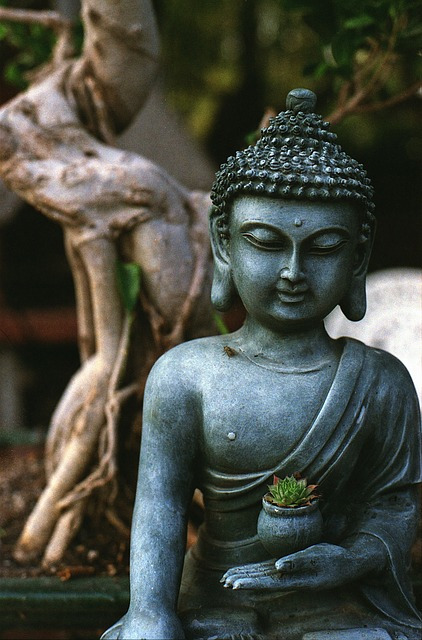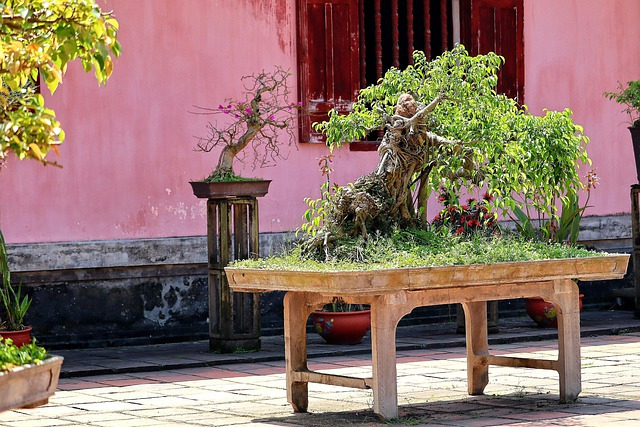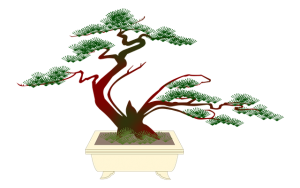Over hundreds of methods, the Japanese bonsai aesthetic values has actually inscribed some important methods and also aesthetic guidelines. Like the kind of visual guidelines that govern, for instance, Western common method period songs, bonsai’s guidelines help experts function within an established custom with some assurance of success. Guidelines alone do not ensure a successful outcome. These style rules can rarely be broken without minimizing the effect of bonsai sampling.

Bonsai looks are the visual objectives and characteristics of the Japanese custom in the art of growing a small tree in a container. Several Japanese cultural features, particularly the influence of Zen Buddhism and the expression of Wabi or Sabi, notify the bonsai tradition in that society. A lengthy brochure of conventional tree forms and also styles aids supply cohesion to the Japanese styling tradition. A variety of other cultures around the world have actually taken on the Japanese method to bonsai, and while some variants have actually started to appear, most hew closely to the guidelines as well as style ideologies of the Japanese tradition of Bonsai aesthetic values.
Bonsai styles

Main short article: Bonsai designs
Vital design practice in bonsai is a set of typically understood, called styles that describe approved tree and also setting styles. These well-known styles supply a practical shorthand means for connecting concerning existing bonsai and for designing brand-new ones. Bonsai styles define a number of standard characteristics of a bonsai, such as the angle and also straightness of its trunk, its branch setup, and the number of trees in the bonsai container.
Similar to all visual policies or standards, the various accepted styles will certainly lead a bonsai developer yet are not totally deterministic. The types of the bonsai, the age of the tree when it began bonsai training, the tree’s pre-existing shape and also structure, also the bonsai musician’s training and preferences, highly influence the form of the resulting bonsai. These completing affects ensure that the design system acts mostly as an innovative aid, not a controlling restraint, in generating a completed bonsai.
The visual appeals of penjing, a Chinese kind of a container-grown tree, stand out from those of bonsai as well as are talked about somewhere else. The aesthetics of saikei, Japanese multi-tree landscapes in a container, are additionally distinct as well as are not described in this post.
General aesthetic concepts
The major goal of bonsai visual methods is to create mini trees with an air of age in their overall shapes, percentages, as well as information. The ultimate bonsai is a single, overshadowed tree in a tiny container. It has the appearance of a mature tree, but not of a totally all-natural one. Instead, a developer or artist has controlled the shape and also surfaces of the tree to overemphasize the tree or enhance’s obvious age, as well as additionally to give it a specified “front” where it is implied to be watched. Any individual examining the effect of the bonsai designer’s work can examine the high quality of the design by viewing it from the rear, where precisely the very same trunk, as well as branches, will generally look unpleasant, chaotic, or otherwise unappealing.
The system of styles serves several purposes, some functional, some aesthetic.:3 -1 In their most basic and most usual application, styles give a form of shorthand description for bonsai samplings. Predefined designs also aid the developer in making a growth strategy for a pre-bonsai tree. The inexperienced specimen might have attributes that recommend or rule out certain styles. The designer can review the pre-bonsai sampling against the catalog of approved designs to establish what branches to reshape or eliminate, what vegetation to remove or urge, as well as what thorough forming to put on trunk and branches.
No trace of the artist
If a branch is removed in forming the tree, the mark will certainly be positioned at the “back” of the tree where it can not be seen. The circuitry ought to be eliminated or, at the very least, concealed when the bonsai is revealed and also must leave no permanent marks on the branch or bark.
Visual balance
Other guidelines resolve the balance of visual weight among the trunk, origins, vegetation, as well as branches. The substantial directory of acknowledged tree styles develops components of this collection of guidelines. The term “balance” right here might describe either:
Proportion amongst aspects
Another basic guideline touches on the proportion of the bonsai’s different aspects. One of the most prized percentages imitates those of a mature tree as carefully as feasible. Slim branches with hefty fallen leaves or needles that are out of proportion are prevented, as is a slim trunk with thick branches. Among minority exceptions to this standard is that flowers and also fruit (on trees that produce them) are ruled out to be flawed if they show up also big for the tree.
The versatility of the policies
Several of the approved guidelines of bonsai type can be curved or damaged for a particular tree without ruining its basic visual and imaginative influence. Going beyond the prescribed guidelines allows visual development in the bonsai art, as seen in several of the work of arts developed by Masahiko Kimura as well as Kunio Kobayashi (bonsai artist).
static aesthetic equilibrium, where the careful application of balance leads to a peaceful as well as secure form (like the official upright, or Chokkan, design), or
vibrant visual balance, which might emerge from an uneven shape or one that suggests instability and also activity (like the cascade, or Kengai, design).
In practically all layouts, the customer can see completely through the tree’s negative rooms to the background behind it. In this combination of negative and also favorable shapes, bonsai looks overlap to a specific level, with the visual appeals of sculpture.
General aesthetic standards
The complying with features are desirable in lots of Japanese bonsai and various other designs of container-grown trees, whatever the design:
Nonessential
Bonsai artists sometimes create or emphasize the appearance of deadwood on a bonsai tree, reflecting the occasional presence of dead branches or snags on full-sized trees. The presence of deadwood is not as common as most of the other points mentioned here but can be used very effectively on selected tree species and bonsai styles
Nebari
Known as “buttressing,” the nebari is the visible spread of roots above the growing medium at the base of a bonsai. Nebari helps a bonsai seem based as well as well-anchored and also make it look mature, comparable to a full-sized tree
Miniaturization
By meaning, a bonsai is a tree that is maintained small sufficient to be a container-grown while or else cultivated to have a fully grown appearance. Bonsai can be categorized according to size. Mame is preferably much less than 10 centimeters (4 inches) high and also can be held in the hand of the hand. Shohin has to do with 25 centimeters (10 inches) tall, while other bonsai are larger as well as can not be quickly moved. For both functional and aesthetic reasons, the standards detailed here are usually most effective and also most typically related to bigger bonsai, while the tiniest specimens of bonsai may adhere to no policies aside from “miniature tree” and “expanded in a container.”
Lignification
This refers to improving the “woody-ness” of a bonsai’s trunk and branches so that they have a mature appearance. This normally implies the bark surface is encouraged to end up being harsh and also dark-colored. Sometimes, this aesthetic technique will vary, as in a birch tree bonsai achieving the white shade as well as exfoliating bark of a mature specimen.
Curvature
Bonsai can achieve a sense of age while remaining straight and upright, but many bonsai rely upon the curvature of the trunk to build the illusion of weight and age. Branches are also curved and recurved to help them fit the designer’s requirement for “positive space” and to separate small branches so that they do not collide or cross.
Leaf Reduction
Leaf reduction is associated with the basic miniaturization explained above; however, it is something which differs over the life process of a certain bonsai. A bonsai’s fallen leaves might be allowed to obtain full size for numerous years in order to urge vigor and development of trunk, origins, and also branches. It is typically desirable to obtain a level of fallen leave reduction prior to displaying a bonsai. Fallen leave reduction might be urged by trimming and also is, in some cases, accomplished by the total defoliation of a bonsai during one part of its expanding season. Conifer needles are a lot more challenging to decrease than various other kinds of vegetation.
Asymmetry
Bonsai visual appeals prevent rigorous balance in the branch as well as root positioning. Left-right (bilateral) proportion throughout the trunk is likewise prevented, and designers function to alternating branches amongst the left, right, and back components of the tree without ever before putting two branches at the very same height or expanding two branches the exact same range away from the trunk.
Implication
The ramification is the splitting of branches and also twigs into smaller sized ones. It is urged by pruning as well as may be incorporated with practices that promote fallen leave decrease.
Gravitas
This is the attribute that all of the remaining points of appearances seek to create. It is a sense of physical weight, the impression of mass, the appearance of maturation or innovative age, and also the elusive top quality of self-respect. Several of the formal rules of bonsai help the cultivator create a tree that shares Wabi or Sabi, or portrays an element of mono no mindful.
General visual guidelines

To support the basic goals and also concepts of bonsai looks, a variety of detailed heuristics are shown in the bonsai custom and recorded in its literature (somewhat comparable to the bonsai designs). Example guidelines consist of:
- The tree will certainly appear in an official container, reasonably little contrasted to the tree.
- With the exception of the tree( s) and also optional spots of moss, nothing else plant life should appear in a bonsai container.
- Other than for the dirt, enabled vegetation, as well as optionally natural-looking rocks, no other things must show up in a bonsai container.
- The tree will have a distinct “front” where it is intended to be checked out.
- The trunk must taper considerably from base to top.
- The tree’s rootage ought to be exposed at the base of the trunk as well as must flare wider than the trunk as it enters the ground.
- No noticeable origin needs to cross another.
- Branches must begin about one-third of the method up the trunk as well as be constant from there to the suggestion of the trunk (this standard is specially made the literati, or Bunjin-gi, design).
- Branch size must decrease from the base to the top of the tree.
- No significant tree branch must cross the trunk when checked out from the tree’s “front.”.
- Branch ramifications, especially in deciduous trees, ought to increase towards the pointer of each branch.
- Branch form must mirror the weight old, specifically in conifers, and also branches may be formed to have a tendency downwards toward the idea in assistance of this technique.
- The trunk might be a straight vertical form or maybe contorted in different instructions over its length, yet in vogue where the tip of the tree is above the container, the suggestion should turn a little forward at the top (towards the audience).
- Vegetation (leaves or needles) ought to be small and also to range with the tree and also its branches.
- All trees in a multi-tree bonsai planting need to be of the same varieties.
The species of the bonsai, the age of the tree when it began bonsai training, the tree’s pre-existing shape and structure, even the bonsai artist’s training and preferences, strongly affect the shape of the resulting bonsai. For both aesthetic and practical reasons, the guidelines outlined here are generally most effective and most often applied to larger bonsai, while the smallest specimens of bonsai may adhere to no rules other than “miniature tree” and “grown in a container.”
Bonsai styles describe a number of basic attributes of a bonsai, such as the angle and straightness of its trunk, its branch configuration, and the number of trees in the bonsai container.
Bonsai artists sometimes create or emphasize the appearance of deadwood on a bonsai tree, reflecting the occasional presence of dead branches or snags on full-sized trees. Bonsai can achieve a sense of age while remaining upright and straight, but many bonsai rely upon the curvature of the trunk to build the illusion of weight and age.
